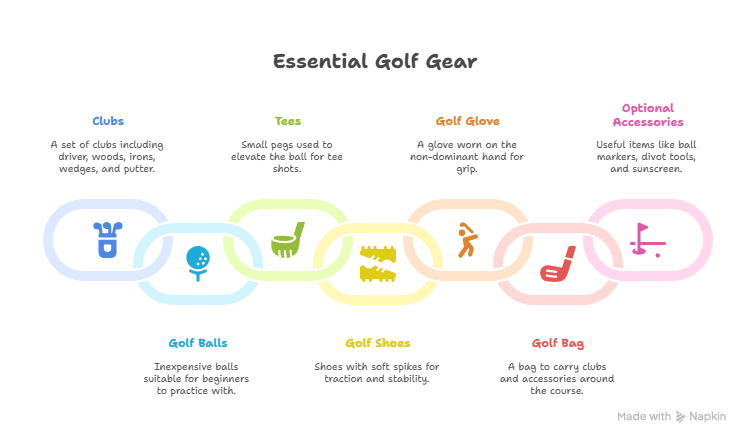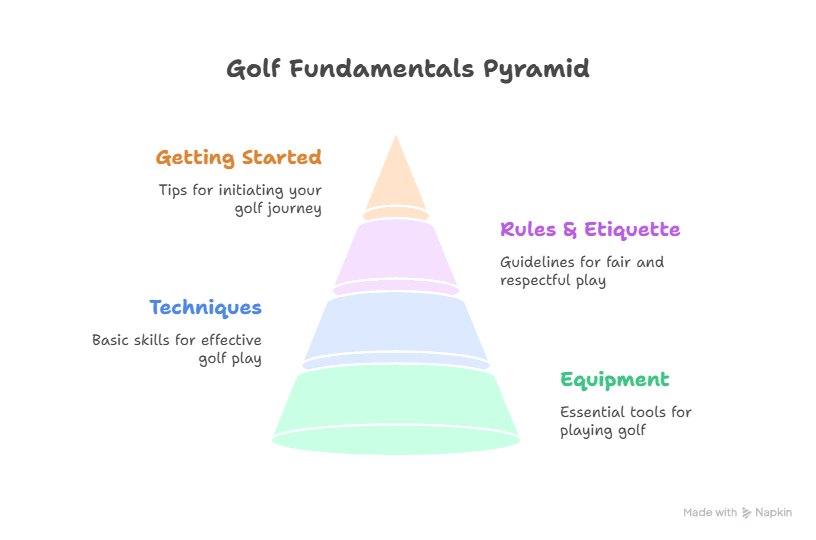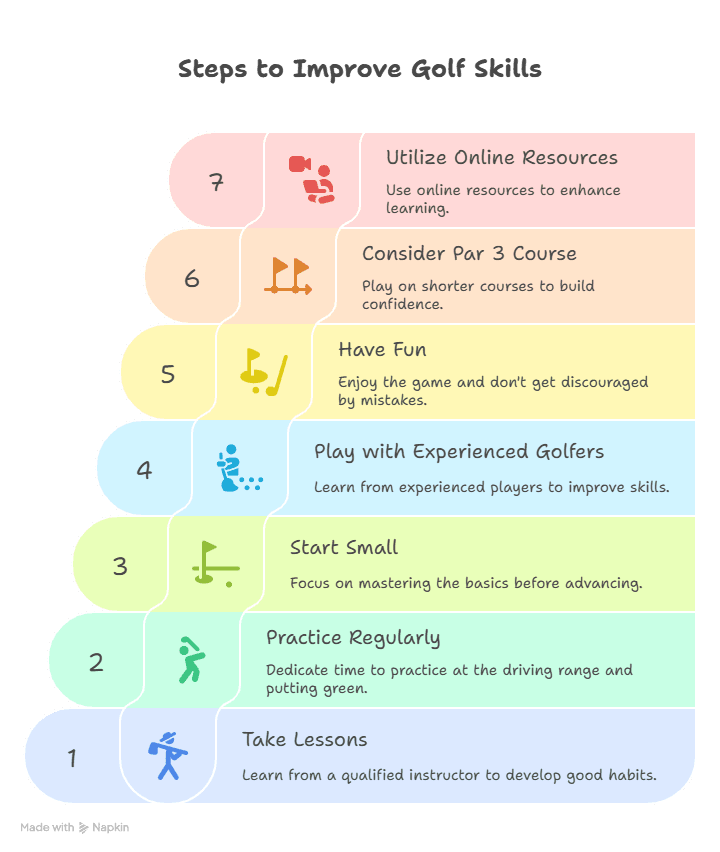Top Takeaways and Key Concepts
→ Start with essential gear by choosing beginner-friendly clubs that feel comfortable and easy to handle.
→ Practice a smooth swing using balanced posture, even weight, and steady rhythm for control.
→ Focus on putting basics like grip, stance, and smooth motion to improve short-distance accuracy.
→ Follow golf etiquette by respecting others, fixing divots, and keeping the course clean.
→ Join beginner lessons or groups to learn faster, gain confidence, and enjoy the golf community.
Summary of This Article
This article introduces beginners to golf fundamentals—selecting the right gear, mastering swing control, and learning putting techniques. It also covers essential golf etiquette and the value of lessons for building confidence. By applying these simple principles, new players can improve quickly, play responsibly, and enjoy every round with growing skill and enthusiasm.
Video Summary
Please Note: This post may contain affiliate links. If you click one of them, we may receive a commission at no extra cost to you. As an Amazon Associate, I earn from qualifying purchases.
So, you’ve decided to dive into the world of golf! Congratulations! It’s a game filled with fresh air, sunshine, and just enough frustration to keep things interesting. Whether you’re looking to impress your friends or simply want an excuse to wear those snazzy golf shoes, this guide will help you navigate through the basics of golf for beginners. Let’s tee off!
Understanding the Basics of Golf

“Golf is a game of inches. The more you know about the basics, the more you can avoid hitting those inches in the wrong direction!” — Unknown
Golf is more than just hitting a ball around on a huge green field; it has a long history and rules of behavior. But don't worry! You don't need to have a PhD in golf to get started. What is the main goal? Get the little white ball into a sequence of holes with as few strokes as you can. It's easy, right? Yes, kind of.

Let's start by talking about gear. You will need some clubs. Most beginners start with a driver, a putter, and maybe a few irons. I can guess what you're thinking right now: “Do I really need to spend all my money on golf gear?” And the answer is a big no! You don't have to spend a lot of money on fancy gear right away. There are actually a lot of choices that won't require you to sell your car to get started.
Let's start with the driver, which is the massive stick that sends your ball screaming down the fairway like it's in an Olympic sprint. This club is made for distance, so find one that feels nice in your hands. Hold it like you're holding onto a slippery fish: not too tight, but not so loose that it slips away while you're swinging! And speaking of grip, don't forget to think about the size. If your hands are little, make sure to select a driver with a grip that fits you. Playing with clubs that are too big can feel like trying to swing a tree trunk!

Next is the putter. It's the bag's hidden gem! This tiny guy might not be as cool as the driver, but he will help you save strokes when you're on the green. When you choose a putter, think about how it feels in your hands. Does it make you feel good? Can you see yourself making the three-footers that matter? If not, keep searching! There are a lot of different kinds of putters. others who want to be more accurate should use blade putters, while others who want to be more forgiving should use mallet putters. Pick the one that makes you feel like Tiger Woods, or at least like his less renowned cousin.
Next are irons, which are the best clubs in your bag. These gorgeous clubs, which are normally numbered from 3 to 9 (with lower numbers being longer clubs), can help you with everything from long strokes on the fairway to challenging approach approaches on the green. It's normally better for novices to start with a set that has mid-irons, such 7 or 8. These clubs provide you more control while still letting you strike the ball a long way.
Now comes the fun part: obtaining your clubs! You might want to buy new sets that dazzle in the store, but secondhand clubs can operate just as well and cost a lot less. Check out local businesses or online marketplaces where experienced golfers sell their used gear for cheap. Think of them as gems that are ready to go on their next trip!
Did you know that the term “fore” originated from the Scottish word “before”? Golfers shout it to warn others ahead of them, but it often sounds like an exclamation before your ball goes wildly off course! So, in essence, you're just letting everyone know you might be sending a surprise their way!
In the end, the most important thing is to pick something that feels good in your hands. Golf should be fun, not a frustrating workout because your gear doesn't fit right. So spend some time at your neighborhood pro shop or sports goods store. Try swinging several clubs and see which ones make you feel like you're ready to take on the course instead of running away from it! No one wants to play with gear that feels like it was made for giants or, even worse, a knight getting ready for battle in the Middle Ages!
To sum up, while choosing your first set of clubs, comfort should be more important than cost. With time and practice—and maybe some helpful tips from other players—you'll quickly find the right pieces for your golf journey!
Now let's talk about the course. Golf courses come in many forms and sizes, but most of the time they have 18 holes. If you're feeling lazy, they might only have 9. Every hole has its own set of problems, like bunkers (the sandy traps), water hazards (sometimes known as “the ball-eating monsters”), and other types of terrain that can make even the best players sweat bullets.
Learning the Swing

“Golf is a game where you yell ‘fore,' shoot six, and write down five.” — Paul Harvey
Yes, the swing is the most famous part of golf. To be fair, it might look easy at first: stand behind the ball and swing your club like you're trying to swat away a fly. But believe me when I say that there is more to it than merely waving your arms around.
To begin, make sure you're standing correctly. Feet shoulder-width apart is always a good idea. Bend your knees a little and keep your weight evenly distributed between your feet. Think about it: would you try to jump on one leg while carrying groceries? That's right! Stability is quite important here.
When it's time to swing, speed isn't as important as smoothness. I mean, who wants to appear like a chicken that's going crazy trying to fly? Taking your time with your backswing usually makes you more accurate than racing through it like you're late for dinner and the roast is burning. Picture this: you're in a magnificent ballroom, and instead of waving your arms around like a crazy person, you're gliding over the floor with style. When you swing your golf club, that's the kind of vibe you want!

Now, let's talk about why smoothness is so important. Taking your time on the backswing lets your body get into the appropriate position without feeling rushed or strained. If you pull the thread too rapidly, the toy can merely flop over instead of shooting ahead. It's like winding up a toy before letting it go. The same idea applies here: taking a moment to gather your energy and balance can help you make a more powerful and controlled shot.
Instead of being a crazy windmill, think of yourself as a lovely dancer. Rhythm always beats chaos! You don't want your swing to appear like a scene from a slapstick comedy where everything goes wrong in a funny way. Instead, look for that groove where each motion leads into the next. Take a deep breath before you start your swing. This will assist settle your anxieties and make your body ready to move smoothly.
When you start your backswing, try to make it feel both planned and comfortable. Your arms should raise effortlessly, and you shouldn't feel any tension in your shoulders. No one wants their upper body to get stiff like they're getting ready for an embarrassing hug! Picture each limb functioning together: your legs are stable, your hips are spinning slowly, and your arms are rising over your head like they're reaching for something tasty on a high shelf, like cookies! It's not just about looking nice; it's also about getting ready for success at impact.
Did you know that the average golfer will spend more time practicing their swing than they do on actual golf courses? In fact, if practice made perfect, most golfers would be pros by now—except for the tiny detail that they keep trying to fix their swing while standing over a ball instead of just hitting it!
And speaking of impact, this is when all that seamless planning pays off! That patient buildup will make sure everything is in the right place, which will help you hit the ball cleanly instead of sending it on a crazy excursion to the nearest water hazard or sand trap. Don't forget that golf is about more than just power; it's also about accuracy!
So the next time you're out there swinging like you're in a storm, take a deep breath and remember that smoothness always wins over speed! Let your inner dancer out; give each move its own space and rhythm, as if you were dancing in front of an audience (even if it's simply squirrels observing from trees nearby). Not only will you get better at golf, but you'll also love every minute you spend on the course, even when things don't go as planned! Golf should be entertaining, and what could be more fun than dancing with nature while you work on your swing?
Mastering Putting
“Putting is like love. You have to approach it with the right mindset and a little bit of finesse.” — Unknown
Putting can feel like attempting to tame a wild animal. It appears easy until you have to deal with those hard slopes or annoying breaks on the green! Putting is interesting since it makes up about 40% of all strokes in a round of golf. So why not spend some time getting good at this? You might even want to invest in an indoor putting green.
First, get used to your putter, which is a club made just for short distances on the green. It's like the reliable friend in your golf bag that is always there to help when you're only a few feet from the hole. You might believe that all clubs are the same, but the putter has its own special charm and skill that needs some care and love.
Make sure your eyes are right above the ball as you stand over it. This will help you line it up better so you don't send it zigzagging across the course like it's trying out for “Dancing With The Stars.” If you try to balance a pencil on your finger while looking at it from an unusual angle, it won't end well! If you keep your eyes lined up, you'll have a better idea of where you want that little white ball to go.
Now, let's speak about how to stand. Your feet should be shoulder-width apart, which will provide you a strong basis. Imagine yourself as a tree in a light breeze. It's also important to have a sturdy base because if you're wobbling around like a kid learning to walk, good luck making that perfect shot! Bend your knees a little and keep your back straight. No one wants to seem like they're executing some strange yoga stance while they putt.
The next thing is grip. You should hold the putter lightly but firmly, like you're cradling an egg. You want to apply enough pressure so you don't drop it, but not so much that it breaks! Some people like to overlap their fingers, while others like to interlock them. Different grips work for different people. Try several things until you find what feels perfect. Comfort leads to confidence!
Take a deep breath and focus on your target—the hole!—as you get ready for that beautiful moment when the ball hits you. Instead of thinking about all the times the ball went off course and into oblivion (or worse, into someone else's line of play), picture it gliding gently toward its goal. Imagining how good it will feel when it rolls in can help. I all, who doesn't like seeing that little flag waving in victory?
Did you know that the word “putt” is derived from the Scottish term “put,” which means to push? Ironically, many golfers would argue that their putts often seem more like a “pull”—especially when they miss an easy shot and end up pulling their hair out instead!
And now it's time for the exciting part: creating the stroke! Let yourself swing back and forth smoothly, without any jarring motions. Instead of flailing around trying to catch butterflies, think of it as softly relaxing in a hammock. Trust me, smoother strokes work better. Don't look too soon; it might turn even the best plans into a tragedy!
So keep in mind that getting comfortable with your putter isn't only about learning how to use it; it's also about building a relationship based on trust and familiarity. If you maintain everything in line, from your stance and grip to your seamless execution, you'll turn those short putts into big wins instead of crazy runs over greens everywhere! Get out there and show those balls who's in charge; they won't know what hit them!
As you softly stroke the ball toward the hole, keep everything stable. You don't need to be as strong as the Hulk! Keep in mind that smoothness is important again. Picture yourself pushing an egg across the floor instead of shattering it to bits.
Golf Etiquette: The Unwritten Rules
They claim that manners matter everywhere, even on the golf field! One thing that every novice should learn immediately is how to behave on the golf course. Nothing shouts “newbie” like accidently coming into someone else's shot. You could possibly save yourself some embarrassment by reading a book about golf etiquette.
First of all, constantly be mindful of the other players around you. It's important to wait for them to finish before you move forward. Imagine this: you're in line for the ideal shot, feeling calm and ready to harness your inner Tiger Woods when someone swings their driver right next to you. Your focus flies away like a scared bird. It's not just distracting, but no one wants to wear their driver as an ornament! When you're on the golf course, you should be respectful and friendly. Keep an eye out and let others finish their turn.
Now that we've talked about patience, let's talk about manners. It's not just about hitting the ball; it's also about being polite to everyone else on the green. If you notice someone getting ready to putt or take a shot, wait until they've had their turn before you swing. I mean, nobody wants to feel like they're in a golf version of “The Hunger Games,” when every stroke counts and distractions might lead to disaster. So take a deep breath and enjoy the game's flow while giving others room. They'll be more grateful than you know!

Now, let's talk about another important part of golf etiquette: fixing any divots or ball marks that were left behind. When you hit that perfect drive down the fairway or send a ball flying toward the hole, things might get a little messy. For example, you might accidently knock over Grandma's favorite garden gnome at family dinner (yikes!). Fixing those divots isn't just polite; it's necessary to keep the course looking great for everyone who plays after you. Think of it as leaving behind only nice vibes.
If you see a ball mark from your last shot (or someone else's) while you're on the green, grab your beloved repair tool (which should surely be in your golf bag) and carefully push the grass back into place. Putting things back in order is like tucking in a loose strand of hair. Plus, by performing this easy thing, you're making the experience better for other golfers.
And we can't forget about those annoying divots on the fairway! If you accidentally hit a piece of ground with your swing (it happens to all of us), take a moment to put it back where it belongs. You could feel like a superhero putting things back in order, but believe me, future players will be grateful when they don't have to avoid craters that look like moon craters!
In golf, it's considered poor etiquette to talk while someone is putting. However, if you really want to break the silence, just remember: nothing says “I care” like asking your buddy if they think the ball will make it into the hole before they've even taken their shot!
To sum up, being thoughtful on the course means more than just making amazing shots. It also means respecting other players and taking care of the surroundings we all share. We make the game more fun by being patient with other players and taking care of the beauty of each hole by fixing things when they break. So the next time you're out there swinging away in the sun, remember to leave nothing but footprints and happy feelings!
And don't forget about the dress code; many courses have specific requirements about what to wear (sorry, but shorts might not be enough everywhere). So check beforehand so you don't show up looking like you just got out of bed!
Finding Your Local Golf Course
Now that you know about swings and proper behavior, let's talk about how to discover local classes where you may make your fantasies come true—or at least have fun without too much shame!
A fast search on the internet can show you nearby possibilities, from public parks where you may play casually to private golf facilities that need memberships (and maybe even secret handshakes). Some of these private clubs can have more restrictions than a high school prom, no joke! There are beautiful greens with great vistas and strange small courses that seem like they were made by someone who really liked mini-golf. The variety is what makes it so appealing!

Websites often provide reviews too, so do some digging before heading out—you wouldn’t want surprises waiting at every hole! Imagine showing up excited for your first round only to discover that the course is in worse shape than your uncle’s backyard after a family barbecue. Reviews can be golden; they give you insight into what to expect. Are the fairways well-maintained? Is there a snack bar that serves hot dogs as big as your arm? These are vital pieces of information for any beginner golfer.
And let’s not forget about checking out social media! Many golf courses now have Instagram pages showcasing their beautiful landscapes and happy golfers posing with their trophies—or in some cases, their “I almost made it” expressions. This can give you an idea of what kind of vibe each place has. Are folks smiling and having fun, or does it look like they’re all stuck in a serious game of chess?
On top of that, don’t hesitate to reach out directly to the courses you're interested in. A friendly phone call can go a long way! Ask about tee times, equipment rentals, or even if they offer lessons for newbies like yourself. You might even get insider tips on when the best time to play is—because nobody wants to face a crowded course where everyone seems better than you (trust me!).
Did you know that some golf courses are so well-hidden that they could be mistaken for secret lairs? In fact, one golfer joked that if you can't find your local course, just follow the sound of frustrated swearing and the occasional club being tossed—it’s bound to lead you right to it!
Finally, think about joining online or in-person golf organizations or forums in your area. There are a lot of communities where people who enjoy the same things as you do can share their experiences and advice. And who knows, you might even meet some new pals that want to play golf as much as you do! So, whether you want a laid-back afternoon or something more upmarket, doing your homework can make all the difference between a normal day on the course and one you'll remember fondly, hopefully without any embarrassing moments like losing balls or missing swings!
But what matters most? Have fun looking into different classes! Each one has its own personality, from lush green areas that look like paradise islands to rough areas that look like they came from a wilderness expedition. You never know what you'll find until you step foot on that first tee box!
Joining Lessons or Groups
If you're feeling overwhelmed by all this information (which is totally normal!), consider joining lessons or groups designed specifically for beginners—it can be less intimidating than tackling everything solo while also making new friends along the way!
Local community centers often offer group classes led by certified instructors who love sharing their passion—and trust me when I say learning alongside others makes all those awkward moments feel less daunting because everyone starts somewhere!
Did you know that many golf pros believe that taking group lessons can significantly improve your game? It's not just about the instruction; it’s also about the camaraderie! One golfer humorously noted that joining a lesson is like joining a book club—except instead of discussing plot twists, you're debating the merits of a 7-iron versus an 8-iron while trying to avoid hitting each other with stray balls!
Plus, being a member of these clubs gives you access to not only useful ideas but also chances to compete with other members in fun ways. Who doesn't love bragging rights after making that impossibly long putt?
As we finish this beginner's guide to golf, remember that practice makes perfect and that learning something new is always more fun when you laugh. So get your clubs and hit the greens. Adventure awaits you in nature's magnificence, and you might even make some new friends along the way!
Featured Snippet: To start playing golf, focus on the fundamentals—choose beginner-friendly clubs, practice a balanced swing, and develop putting accuracy. Learn proper golf etiquette, stay patient, and consider joining lessons or group sessions to build confidence, meet other golfers, and enjoy steady improvement on the course.
Frequently Asked Questions
What golf clubs should beginners start with?
Beginners should start with a driver, a putter, and mid-irons like a 7 or 8 iron. These clubs provide control, distance, and ease of use while learning.
How can I improve my golf swing as a beginner?
Focus on a smooth, controlled swing with even weight distribution and relaxed shoulders. Avoid rushing, and build rhythm through consistent practice.
Why is putting important in golf?
Putting makes up a large portion of your total strokes. Improving putting accuracy helps lower scores and builds overall confidence on the green.
What are the basic rules of golf etiquette?
Respect other players’ turns, remain quiet during shots, repair divots, and keep the course clean. Good manners create a better experience for everyone.
How can I find local golf courses to practice on?
Search online for nearby public or private courses, read reviews, and contact them about lessons or tee times. Many offer beginner programs.
Is it better to take golf lessons or learn on my own?
Taking lessons helps beginners learn proper form and technique faster. Group lessons also add motivation and community support.
What’s the best way to stay consistent in golf practice?
Set a regular practice schedule focusing on swing mechanics, putting, and short-game drills. Track progress and celebrate small improvements along the way.
Suggested Resources
Golf Basics for Beginners
https://www.golfdigest.com/story/golf-basics-for-beginners
The Complete Beginner's Guide to Golf
https://www.pga.com/learn/beginners-guide-to-golf
How To Choose Your First Set of Golf Clubs
https://www.golf.com/instruction/2020/03/06/how-to-choose-first-set-golf-clubs/

Kevin Collier is an avid golfer and contributing author at AIGolfTips.com, where he shares his passion for the game through expert tips, techniques, and gear reviews. With years of experience on the course, Kevin offers valuable insights for golfers of all skill levels, helping them improve their game and maximize their potential. Whether discussing swing mechanics or the latest in golf technology, Kevin's engaging approach aims to inspire and educate fellow golf enthusiasts to elevate their performance and enjoy every moment on the green.





